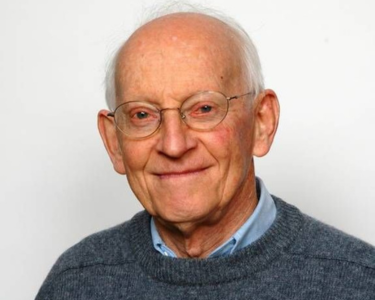ROBERT B. WHITTLESEY: A REMARKABLE LEADER IN THE FIELD OF AFFORDABLE HOUSING
Alexander von Hoffman, The Harvard Joint Center for Housing Studies
No one did more to build the non-profit housing sector in the United States than Bob Whittlesey, who died on February 27 of this year at the age of 101.
Contrary to the top-down approach of housing and urban renewal officials in the 1960s, he insisted on listening to and acting on the wishes of local residents. At a time when the conventional wisdom was that government should bulldoze inner-city neighborhoods, Whittlesey found new methods for nonprofit groups to renovate the homes of low-income city dwellers. To increase the volume of nonprofit housing development, Whittlesey then pioneered the use of intermediary entities to help small community groups finance and manage housing and went on to help create national and international networks of housing practitioners.
In the mid-1960s, Whittlesey created and led what was arguably the first urban community development corporation in the United States, South End Community Development Inc. (SECD). Since 1950, Boston city planners had proposed to demolish great swathes of the city’s South End neighborhood, much of which comprised dilapidated nineteenth-century row houses that either had been abandoned, cut up into apartments, or turned into lodging houses. In 1964 United South End Settlements, an organization of the neighborhood’s settlement houses, hired Whittlesey to help low-income neighborhood residents, many of whom were Black or Hispanic, resist these draconian urban renewal plans, which would have displaced tens of thousands.
Under the sponsorship of the United South End Settlements, Whittlesey helped create and then became the director of SECD. Instead of demolishing derelict row houses, SECD renovated them and, as a result, was able to rent 93 dwellings to low-income households. Rather than imposing plans from on high, SECD invited neighborhood residents, including Black and Hispanic residents, to join its board and help formulate and approve projects. In addition, SECD exploited new federal programs – including the Below Market Interest Rate, Rent Supplements, and leased housing programs – to develop low-income housing. Thanks to Whittlesey’s persistence, SECD obtained the first mortgage that the Federal Housing Administration had reportedly ever insured in the South End, an area that for decades had been considered a slum.
During the late 1960s and early 1970s, citizens of the South End and the nearby Roxbury neighborhood formed several community groups that wished to develop housing. Rather than compete with them, Whittlesey changed the role of SECD to that of a consultant-partner, helping organizations develop new homes as well as remodel existing ones. In an early effort, Whittlesey and Pat Clancy, SECD’s young attorney who became an expert in syndicating tax shelter investments to finance housing development, collaborated with the nonprofit Tenants Development Corporation, which was organized and led by Black renters. Together they rehabbed 56 brownstone rowhouses, 21 of which were located on a run-down stretch of Massachusetts Avenue, one of Boston’s most important thoroughfares.
In another successful partnership, Whittlesey worked with the predominantly Puerto Rican Emergency Tenants’ Council and its sister social service organization, Inquilinos Boricuas en Acción to restore a predominantly Hispanic section of the South End slated for demolition by the city’s urban renewal program. On the site, they developed Villa Victoria, an entire community in the South End of townhouses, apartment buildings, landscapes, plazas, and stores under an outdoor arcade, which is recognized for its excellent design that evokes the colors and forms of traditional Puerto Rican architecture.
In 1970 SECD was renamed Greater Boston Community Development, Inc. (GBCD) and expanded its operations to sites across the metropolitan region. From 1969 to 1982, GBCD helped South End and northern Roxbury community organizations develop over 1,200 units of low-income housing. In 1977, Whittlesey handed Clancy the reins of GBCD, renamed The Community Builders, which today still partners with nonprofits and owns and manages more than 14,000 apartments nationally across the Northeast, South, and Midwest.
In 1983, at the behest of William Edgerly, the CEO of State Street Bank and a prominent Boston civic leader, Whittlesey became the director and later president of the Boston Housing Partnership, which worked with local nonprofit organizations to redevelop deteriorated and abandoned residential properties in many Boston neighborhoods. With financial help from the city’s Neighborhood Development and Employment Agency, the Partnership worked with GBCD to help numerous community groups acquire and successfully redevelop more than 1,800 units of housing. These included the notorious Granite Properties, 51 three- and four-story apartment buildings in Roxbury and Boston’s Dorchester neighborhood that government and private owners had previously tried and failed to preserve, a story I recounted in House by House, Block by Block, my 2003 book on the community development movement. Whittlesey was also instrumental in getting the Partnership to administer 5,000 units of rental assistance. As a result, today the organization, now known as Metro Housing Boston, is Massachusetts’ largest provider of rental housing voucher assistance.
Within a few years, Whittlesey was pursuing an even larger vision. After attending a conference of the United Kingdom’s National Housing Federation in London in 1984, he envisioned an umbrella network of large nonprofit partnership organizations. With funding from the Ford Foundation, in 1989 he toured the country, meeting with housing organization leaders, government officials, foundation officers, and bank executives in 25 cities to study how they might share information and influence national policy about low-income housing. In February 1990, Whittlesey organized a conference in Boston and, building on the enthusiasm of attendees, started the National Association of Housing Partnerships. He then served as its first president and later its chairman. Now known as the Housing Partnership Network (HPN), the group brings together leaders of more than 100 leading housing and community development organizations. It “facilitates peer-to-peer learning and promotes policy and practice that is based on the proven experience of some of the nation’s most successful nonprofits.”
In April 2003, at age 81, Whittlesey returned to London with the directors of twenty HPN member organizations to exchange knowledge with leaders of the British housing federation that had first inspired him to create HPN. He and HPN’s leaders continued to encourage these trans-Atlantic relationships, which in 2009 they formalized as the International Housing Partnership. Today the alliance has 185 members and has inspired housing groups in the United Kingdom, Canada, and Australia to set up network associations like HPN in their own countries.
Whittlesey remained committed to helping local communities, including the one he lived in. In 2003, then-Massachusetts-Governor Romney appointed Whittlesey to the Acton Housing Authority’s Board of Commissioners. Whittlesey, who also found time to publish a memoir in 2018, served as the authority’s chair for 17 years, retiring last year at the age of 100.
A productive life indeed, and one that everyone in the field of affordable housing should celebrate.

